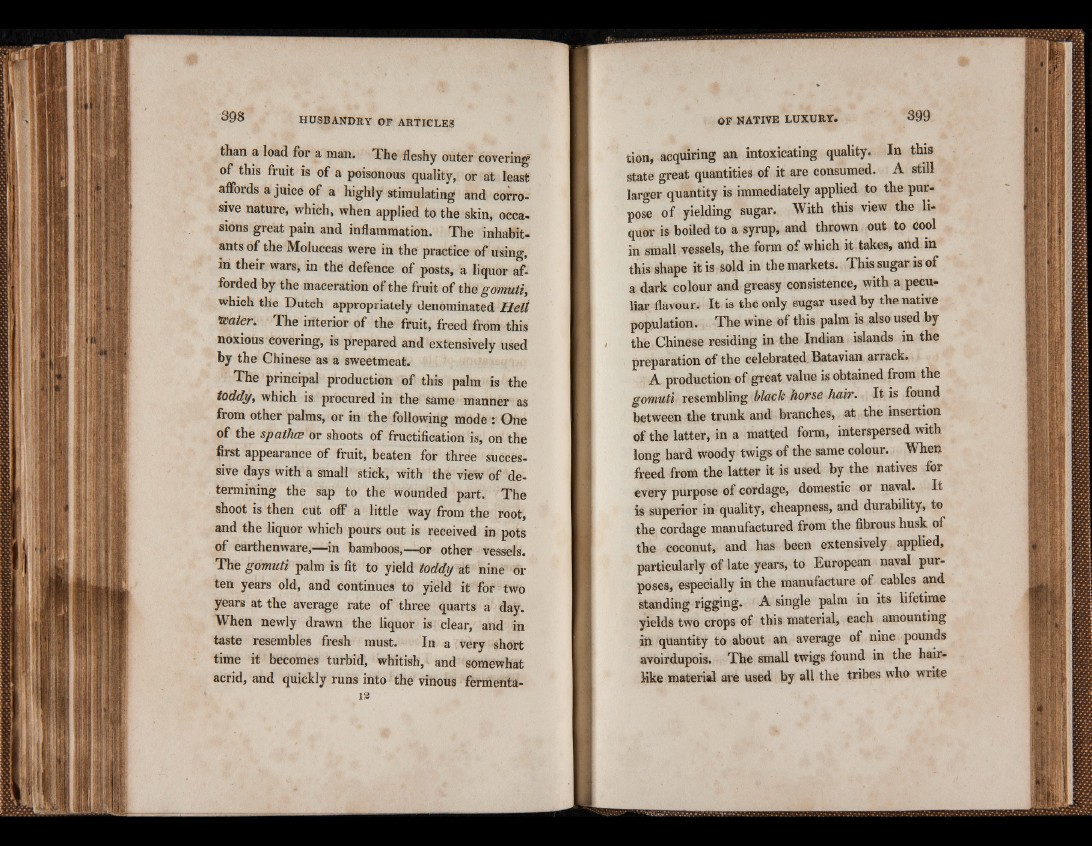
than a load for a man. The fleshy outer covering1
of this fruit is of a poisonous quality, or at least
affords a juice of a highly stimulating and corrosive
nature, which, when applied to the skin, occasions
great pain and inflammation. The inhabitants
of the Moluccas were in the practice of using,
in their wars, in the defence of posts, a liquor afforded
by the maceration of the fruit of tho gomuti,
which the Dutch appropriately denominated Rett
•water. The interior of the fruit, freed from this
noxious covering, is prepared and extensively used
by the Chinese as a sweetmeat.
The principal production of this palm is the
toddy, which is procured in the same manner as
from other palms, or in the following mode : One
of the spathce or shoots of fructification is, on the
first appearance of fruit, beaten for three successive
days with a small stick, with the view of determining
the sap to the wounded part. The
shoot is then cut off a little way from the root,
and the liquor which pours out is received in pots
of earthenware,—in bamboos,—or other vessels.
The gomuti palm is fit to yield toddyat nine 01*
ten years old, and continues to yield it for two
years at the average rate of three quarts a day.
When newly drawn the liquor is clear, and in
taste resembles fresh must. In- a very short
time it becomes turbid, whitish/ and somewhat
acrid, and quickly runs into the vinous fermenta-
12
tion, acquiring an intoxicating quality. In this
state great quantities of it are consumed. A still
larger quantity is immediately applied to the purpose
of yielding sugar. With this view the liquor
is boiled to a syrup, and thrown out to cool
in small vessels, the form of which it takes, and in
this shape it is sold in the markets. This sugar is of
a dark colour and greasy consistence, with a peculiar
flavour. It is the only sugar used by the native
population. The wine of this palm is also used by
the Chinese residing in the Indian islands in the
preparation of the celebrated, Batavian arrack.
A production of great value is obtained from the
gomuti resembling black horse hair. It is found
between the trunk and branches, at the insertion
of the latter, in a matted form, interspersed with
long hard woody twigs of the same colour. When
freed from the latter it is used by the natives for
every purpose of cordage, domestic or naval. It
is superior in quality, cheapness, and durability, to
the cordage manufactured from the fibrous husk of
the coconut, and has been extensively applied,
particularly of late years, to European naval purposes,
especially in the manufacture of cables and
standing rigging. A single palm in its lifetime
yields two crops of this material, each amounting
in quantity to about an average of nine pounds
avoirdupois. The small twigs found in the hairlike
material are used by all the tribes who write